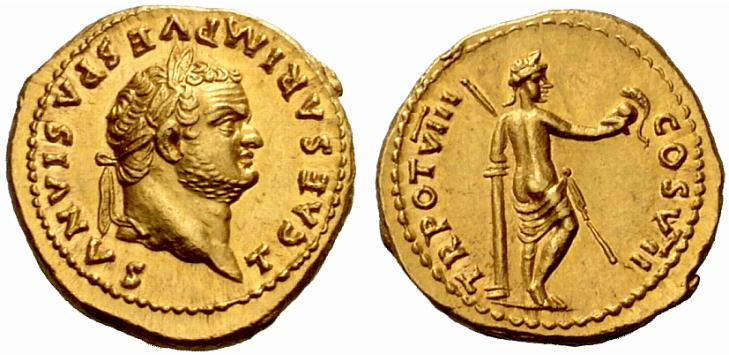August 24, 2016, by Will Leveritt
On this day in AD79 Mount Vesuvius erupted, destroying the towns of Pompeii and Herculaneum
Text by Harry Tanton
The staff at Mint Imperials extend their thoughts and condolences to those affected by the earthquake which today struck central Italy. We turn our thoughts back to a disaster which struck ancient Italy.
Vesuvius stands few miles inland from the Bay of Naples, with a portion of the city of Naples lying close to it. For the eruption of 79, we are fortunate to have the eyewitness account of the Roman senator and man of letters, Pliny the Younger.

AU aureus of Titus, emperor at the time of the eruption. Obverse has laureate head of the emperor r., T CAESAR IMP VESPASIANVS. Reverse has bare-buttocked Venus leaning on column holding a helmet aloft, TR POT VIII COS VII. Image courtesy Classical Numismatics Group.
His friend and fellow senator, the historian Tacitus wished to write about the event and asked Pliny to tell him what he remembered. Pliny wrote twice to Tacitus.
Pliny reports that for several days before the eruption there had been regular earthquakes. Unfortunately nobody seems to have taken much notice because, so he says, such tremors were a frequent occurrence in the area.
As Pliny states, Vesuvius’ initial explosion came in the early afternoon of 24 August, throwing up a huge column of smoke and ash. The ash subsequently began to fall thickly over the nearby fields and towns, as did the lumps of molten rock and pumice thrown out by the eruption. At this point many are said to have begun evacuating the area.
That afternoon, Pliny the Younger’s mother called the cloud to the attention of Pliny’s uncle, her brother Pliny the Elder (author of the Natural History).
The elder Pliny was stationed at Misenum, some 22 miles across the Bay of Naples from Vesuvius, in command of the Roman fleet. Initially, as his nephew tells us, he greeted the sight of the cloud rising above the bay not with horror but with curiosity.
He ordered a small craft to be prepared so that he could examine the phenomenon up close. It was only when he received news that a friend of his was trapped in the bay by unfavourable winds that he ordered the whole fleet to be dispatched to evacuate the populace.
The elder Pliny and his friend Pomponius retired to the latter’s house at Stabiae, where Pliny affected to be unconcerned by events in order to calm his frightened friend. He even had a bath and dinner.
Pliny the Younger and his mother had meanwhile evacuated Misenum, along with many of the other residents. He describes seeing a huge black cloud emanating from the mountain and plumes of fire rising out of it.
The elder Pliny had slept at Pomponianus’ house before being woken at some point on the morning of the 25th. There were now tremors occurring and the group were obliged to decide whether to stay indoors and risk being crushed in the event of the house collapsing, or take a chance outside in the ash- and pumice-filled atmosphere.
They chose the latter, with Pliny the Elder going down to the bay to check if the seas would now allow an escape – but they were too choppy. He sat down on a blanket and there Pliny the Elder is said to have died from the noxious fumes given off by the volcano. However, he is known to have suffered from asthma, so it is likely that the ash-filled air triggered a fatal attack.
It was during the night of the 24 or the early morning of the 25 August that the eruption moved into its second phase, when Vesuvius began throwing out deadly pyroclastic flows in several directions. They moved down the slopes of Vesuvius at terrifying speed, a dense cloud of boiling ash and rock.
It was this that, when it hit, destroyed Pompeii, Herculaneum and Stabiae and covered it in a thick layer of ash and debris. Those who had stayed behind were killed by the hot, choking clouds. Their bodies were covered over in a layer of pumice where they lay, preserving for us the melancholy and tragic casts which captured their final moments.
The eruption had subsided by the 26 August, when, according to Pliny the Younger, the sun could be seen again during the day, having been blotted out by the sheer quantity of ash thrown into the atmosphere.
The eruption occurred a mere two months into the reign of the emperor Titus. Suetonius and Cassius Dio praise him for his reaction to the disaster: they agree that he chose two ex-consuls to coordinate the relief efforts as well as diverting a large amount of money from the imperial coffers to aid the survivors.
Nevertheless, in the aftermath of the eruption of Vesuvius the towns that suffered most – Herculaneum, Pompeii – were abandoned and forgotten until rediscovered via excavations which began in the 1730s and 40s.
No comments yet, fill out a comment to be the first

Leave a Reply